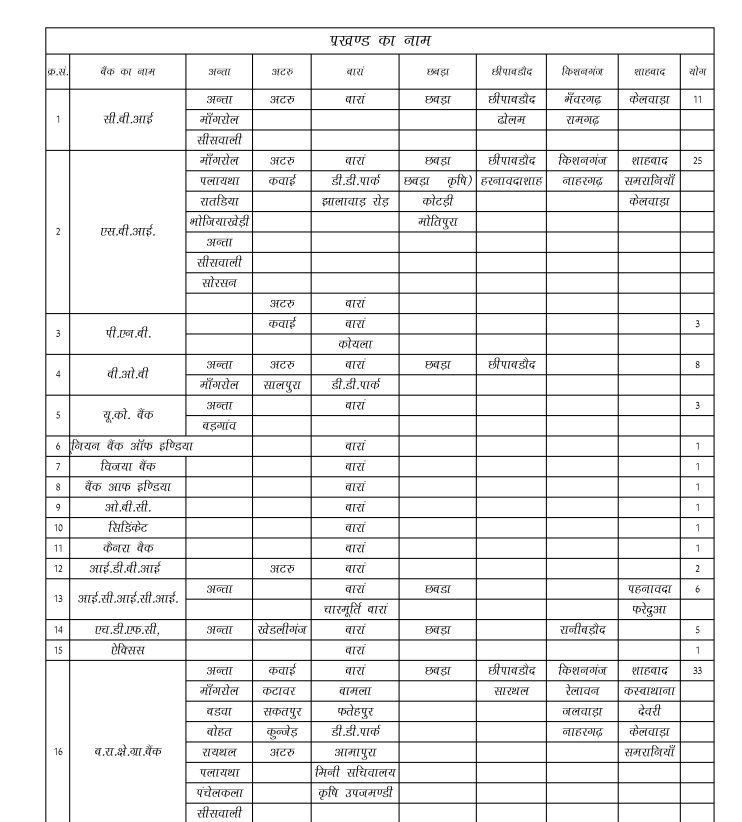|

Mr. Rahul Raikwar
LDM Baran
|
आभार
हम बैंक के माननीय अध्यक्ष एवं प्रबन्ध निदेशक के आभारी हैं जिनके मार्गदर्शन एवं निर्देशानुसार अग्रणी बैंक बारां की वेबसाईट www.ldmbaran.co.in जारी की है। इस वेबसाईट के द्वारा आमजन बैंकों की सरकारी योजनाओं की जानकारी प्राप्त कर सकते हैं। इस वेबसाईट में सभी बैंकों की तिमाही प्रगति एवं सरकारी योजनाओं की जानकारी व सभी बैंकों का सर्विस एरिया प्लान सम्मिलित है। हमें समय-समय पर सुझाव व मार्गदर्शन देकर इस वेबसाईट को और भी जनोपयोगी बनाने में सहयोग प्रदान करें।
|
|
The
study group which was presided over by Prof. DR
Gadgil recommended in Oct.1969 the adoption of an Area approach for the development of credit
and banking in the country on the basis of local
conditions. The group suggested earmarking of the
districts to Commercial Banks so that they could act
as space setters in the districts allotted in
providing integrated banking facilities. The
Committee of Bankers appointed by RBI under the
Chairmanship of Sr. F.K.F. Nariman also endorsed
this area approach. RBI accepted the recommendation
and formulated the Lead Bank Scheme 9LBS) in
Dec.1969. Under the Scheme, each district had been
assigned to different banks (public and private) to
act as a consortium leader to coordinate the efforts
of banks in the district particularly in matters
like branch expansion and credit planning. The
LBS did not envisage a monopoly of banking business
to Lead Bank in the District. The Lead Bank was to
act as a consortium leader for co-ordinating the
efforts of all credit institutions in each of the
allotted districts for expansion of branch banking facilites and for meeting the credit needs of
the rural economy. In the meanwhile, nationalization
of 14 major Commercial Banks in July 1969 (and
another 6 banks in 1980), paved the way for bringing
about dramatic changes in their operations.
One of the important changes ushered in immediately,
was the expansion of the branch network in the
unbanked areas with a view to bridge spatial gaps.
Banks were directed to open a large number of
branches in unbanked rural and semi-urban areas. |
|
1-4-1991 Central Bank of India started a well
established Lead District Manager office in Baran it
is working at Hospital Road, Baran. As
the effectiveness of the Lead Bank Scheme depends on
the dynamism of the District Collector and the LDM,
with supportive role of the Regional/Zonal Office,
usual role of LDMs like convening meetings of the
DCC and DLCR, periodical meetings of DDM//Government
officials for resolving outstanding issues etc. Role
of the Lead District Manager The Lead District
Manager who is appointed by the Lead Bank in the
District, plays a key role in ensuring the success
of the Lead Bank Scheme. The functions of the LDM
include the following:(i)
Identification of potential for formulation of bankable
schemes for inclusion in the Annual Credit Plan (ACP)
(ii) Finalisation of District Credit Plan/Annual Credit
Plan;
(iii) Allocation of shares of DCP/ACP outlays;
(iv) Monitoring overall progress in physical and financial
terms in the implementation of ACP & Government Sponsored
Programmes etc.
(v) Reviewing/monitoring of the support forthcoming from the
Government departments.
(vi) Reviewing the progress in disposal of loan applications
and ensuring that applications are sent in a phased manner
and not in bunches in the last quarter of the financial
year.
(vii) Identifying problems/bottlenecks in the flow of credit
as also of infrastructure inputs etc. and taking steps to
overcome them.
(viii) Overseeing and ensuring smooth release of subsidies.
(ix) Monitoring the recovery position of financial agencies
and rendering necessary help for recovery of overdues.
(x) Taking up with State Government/SLBC/SLCC, items/issues
which could not be tackled at the district level and
ensuring proper follow-upthereof, including security
arrangements, lack of infrastructural support etc.
(xi) Identification of unbanked centres for opening of
branches and reviewing the progress in the opening of
branches.
(xii) Evaluation of the ground level implementation of
various schemes and benefits accruing there under to the
identified beneficiaries.
Lead district Managers objective, role and perception
* Drawing up the road map
for banking penetration
* Monitoring implementation of Annual Credit Plan
* Associate with the setting up of Fiancial literacy and
Credit Counselling Centres ( FLCCs) , RSETIs by Banks
* Holding annual sensitization workshop for banks and
governments officials with participation by NGOs/Public
Relation Instituins(PRIs)
* Arranging for quarterly awareness and feedback public
meetings , grievance redressal etc.
National Goal of Domestics Banks
|
Sector
|
Target |
Of
|
|
Priority sector
|
40 %
|
ANBC or Credit equivalent amount of OFF
Balance sheet exposure, which ever
is higher ( ANBC=NBC+Banks
investment in Non-SLR Bonds held in
HTM category)
|
|
Agriculture ( Direct & Indirect)
|
18 %
|
|
Indirect Agri. (Max)
|
4.5 %
|
|
Weaker Section
|
10 %
|
|
DRI
|
1 %
|
Total Credit ( Min 40% to SC/ST & 2/3rd
through Rural/ Sub Branches) |
|
Women beneficiaries
|
5 %
|
Net Bank Credit
|
|
Export Credit
|
12 %
|
But it is not a part of Priority Sector
for Domestic Banks |
BANKS/ BRANCHES UNDER
BLOCK :

.jpg)
|



.jpg)